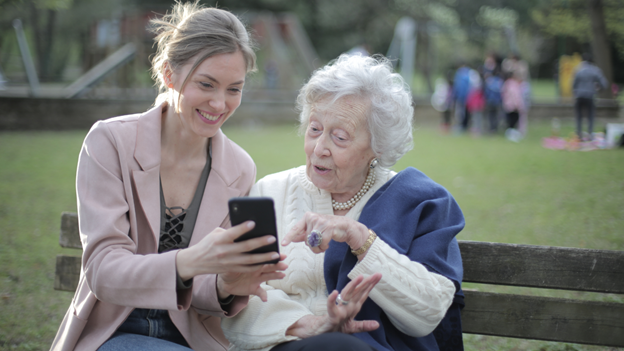7 Tips for Communicating Effectively with a Loved One Who Has Alzheimer’s

Communication challenges are one of the most difficult aspects of caring for a loved one with Alzheimer’s. As the disease progresses, memory loss, confusion, and difficulty processing language can make everyday conversations frustrating for both the individual and their caregivers. However, with patience and the right strategies, it is possible to improve communication and create meaningful interactions.
Here are seven essential tips to help you communicate more effectively with a loved one who has Alzheimer’s.
1. Speak Clearly and Slowly
Alzheimer’s can make it difficult for individuals to process and respond to information quickly. When speaking, use simple and clear language, and avoid complex or long sentences. Speak slowly and calmly, allowing plenty of time for your loved one to process what you are saying and respond.
Instead of: “Would you like to go outside for a walk after breakfast, or do you prefer staying in?”
Try: “Would you like to go for a walk?”
Breaking down your speech into short, direct phrases makes it easier for them to understand.
2. Use Nonverbal Cues
As verbal communication becomes more challenging, nonverbal cues can help bridge the gap. Facial expressions, gestures, and body language can reinforce what you are saying. A gentle touch on the hand, a warm smile, or maintaining eye contact can provide reassurance and make conversations feel more personal and engaging.
If words are difficult to process, guiding your loved one toward an action—such as pointing to a chair when asking them to sit—can be very effective.
3. Stay Patient and Avoid Corrections
It’s natural to want to correct misinformation or remind your loved one of forgotten details, but frequent corrections can lead to frustration and agitation. If they call you by the wrong name or confuse past and present events, gently go along with the conversation instead of forcing them to “remember” things.
For example, if they talk about a loved one who passed away as if they were still alive, instead of saying, “No, Mom, Dad passed away years ago,” try responding with, “Tell me more about Dad. What do you remember about him?” This approach keeps the conversation positive and reduces unnecessary distress.
4. Minimize Distractions
A busy environment can make it harder for someone with Alzheimer’s to focus on a conversation. Try to create a calm and quiet setting when speaking with them. Turn off the television, move away from noisy areas, and maintain eye contact to keep their attention.
If your loved one seems overwhelmed, reducing background noise and focusing on a single topic at a time can make communication smoother and more enjoyable.
5. Ask Simple Questions
Complicated or open-ended questions can be confusing. Instead, ask questions that require a simple ‘yes’ or ‘no’ answer or offer clear choices.
Instead of: “What would you like to wear today?”
Try: “Would you like to wear the blue sweater or the red one?”
Providing structured choices helps reduce frustration and gives them a sense of control over their decisions.
6. Use Reassurance and Positive Reinforcement
Individuals with Alzheimer’s may struggle with self-confidence and experience anxiety over their communication difficulties. Offering reassurance can help them feel more at ease. If they have trouble finding the right word or forget a thought mid-sentence, gently encourage them rather than showing frustration.
Phrases like “That’s okay, take your time” or “I understand what you mean” can provide comfort and make them feel supported. A warm tone of voice and a patient attitude go a long way in building trust.
7. Adapt to Their Communication Style
As Alzheimer’s progresses, your loved one’s ability to express themselves will change. Adapting to their style of communication instead of expecting them to communicate as they once did is key to maintaining a meaningful connection.
If they start using gestures instead of words, respond accordingly. If they use a particular phrase repeatedly, acknowledge it without frustration. Sometimes, the emotional tone behind their words is more important than the words themselves.
Additionally, if verbal communication becomes too difficult, consider alternative methods such as playing music, showing family photos, or engaging in familiar activities together. These nonverbal interactions can help create a sense of connection and understanding.
Communicating with a loved one who has Alzheimer’s requires patience, empathy, and flexibility. By speaking clearly, using nonverbal cues, and creating a calm environment, you can make interactions smoother and more meaningful. Above all, the goal is to provide comfort and reassurance while maintaining a strong emotional connection.
For families seeking additional support, in home care for Alzheimer’s patients can be a valuable resource. Professional caregivers trained in dementia care can help facilitate better communication, reduce caregiver stress, and provide specialized assistance tailored to your loved one’s needs.



